I continue to plant apple trees in my yard because my kids eat so many and they’re easy to grow.
Yes, apples are very easy to grow in Southern California. Some of the best varieties even grow well here despite apples being associated with colder climates. In fact, I’ve found that my apples tolerate heat waves better than my avocados.
Varieties
Everyone likes different apples; my wife prefers a tart Granny Smith whereas I prefer a sweet Granny Smith. Wait, that’s the same apple. But you can pick it early (tart) or late (sweet-tart).
There is something to keep in mind: each apple variety changes in flavor during its season of maturity. You’ll never find a sweet Granny Smith in a grocery store, but that is only because farmers never harvest Granny Smiths as late as you can from your own tree, which is when they start to taste “like a bottle of Martinelli’s,” as a friend of mine put it.
Here is a list of varieties that I know firsthand to be satisfactory to many gardeners in Southern California. That is, I’ve seen them with my own eyes in person in different gardens where they grow happily, fruit abundantly, and taste good (although that part is subjective):
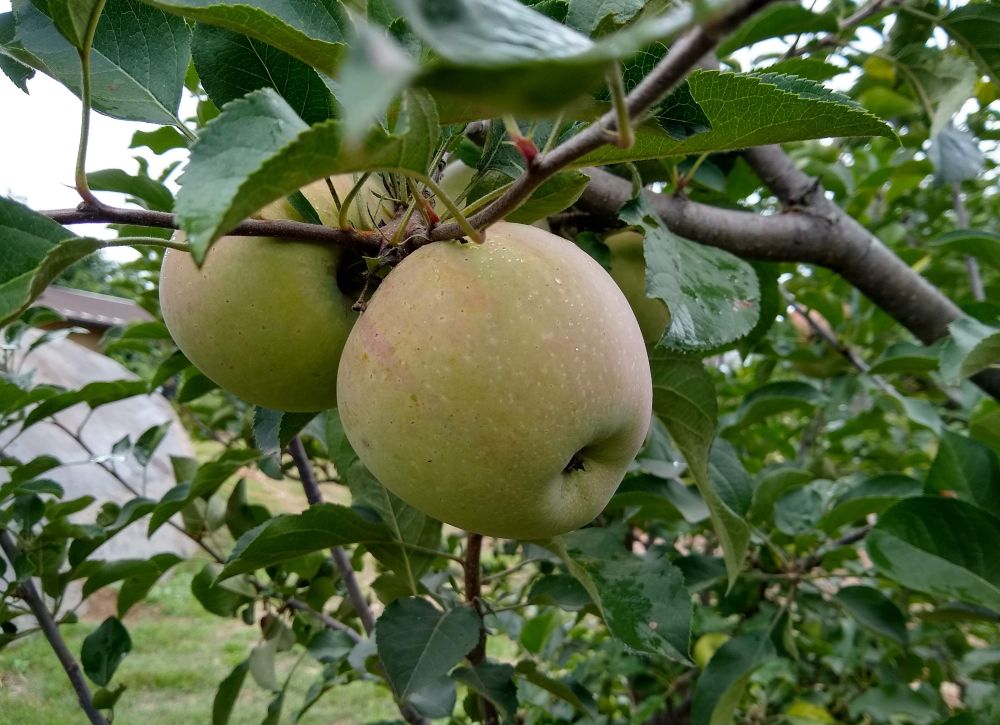
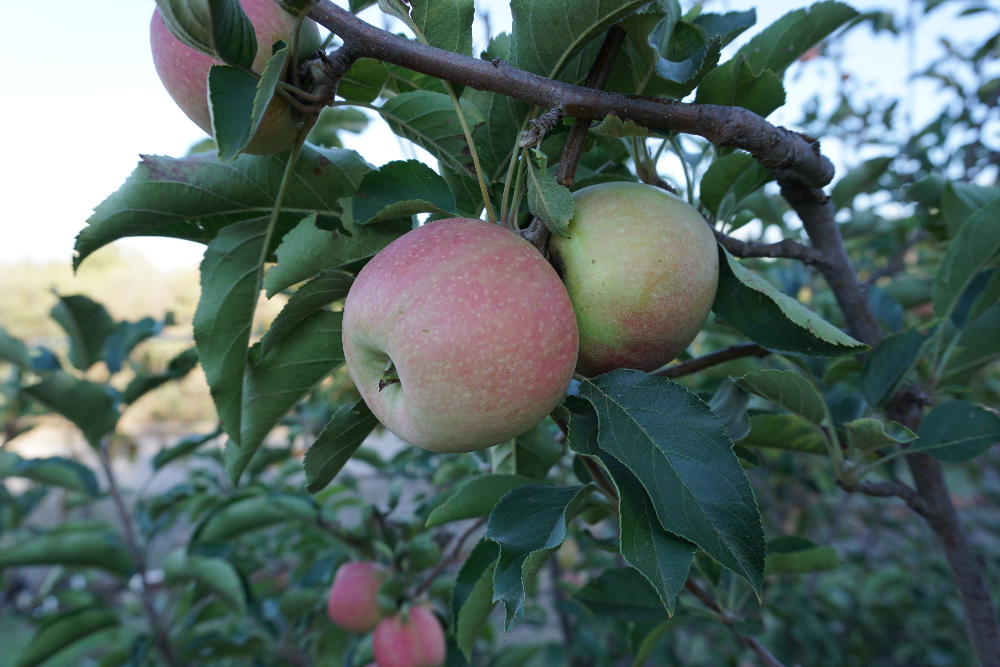
Sundowner (pictured at very top)
Gala (I grow the Buckeye Gala)
There are a hundred other varieties that I’ve seen or heard of doing well in limited Southern California locations. If there is an apple variety that you like to eat, I would try to grow it regardless of what anyone says about that possibility. You have to discover for yourself.
I am currently trying out a handful of varieties that aren’t commonly grown in Southern California, and I’m finding that some don’t perform well but some do. This year I got my first crop of Hudson’s Golden Gem, an old variety from Oregon that came to me via a friend on the Central Coast. It is productive and uniquely delicious.
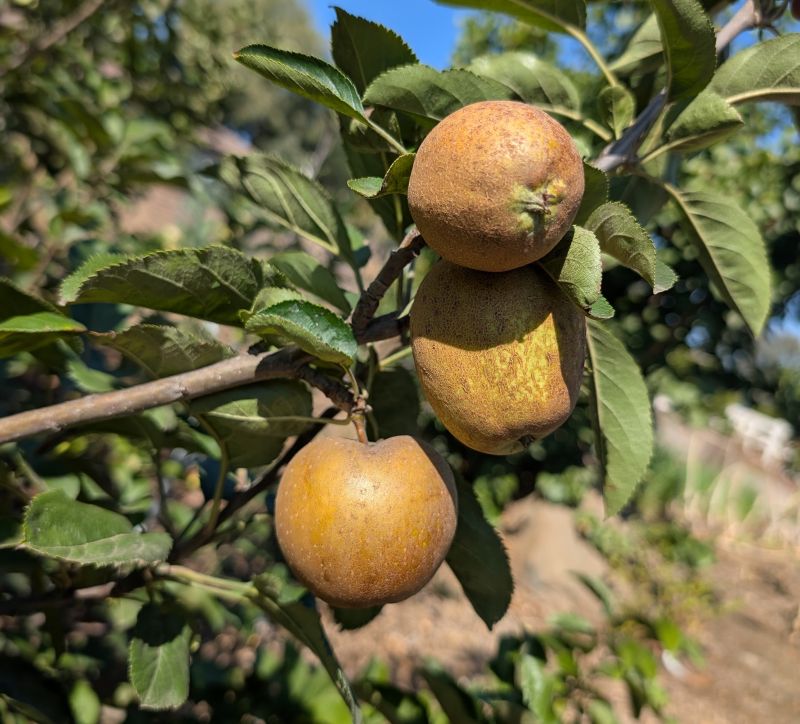
Incidentally, Hudson’s Golden Gem also did well in a trial planting in Irvine so I shouldn’t be surprised.
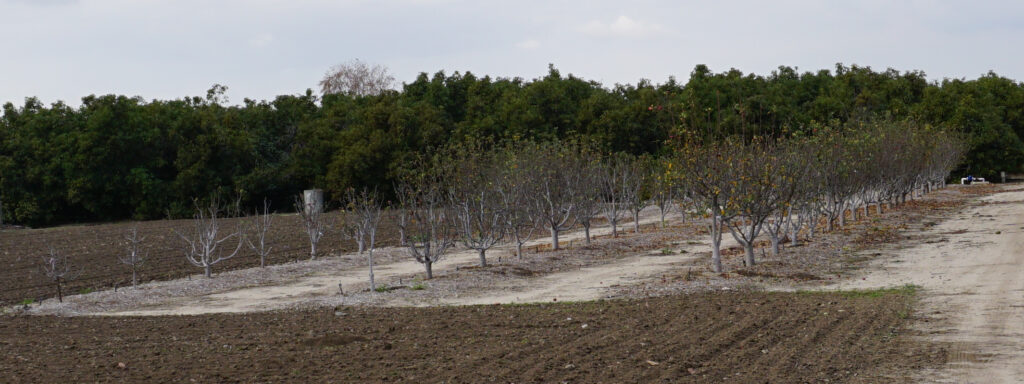
On the one hand, it’s overwhelming to have to choose from so many apple varieties, but on the other hand, it’s a blessing to have so many options because they all mature at different times, from early summer through the fall and winter. As a result, with three trees, say Anna, Gala, and Pink Lady, you can have fresh apples to eat most days from June all the way until January.
Training and pruning
I have come to prefer shaping apple trees to a central leader shape rather than an open center shape. What this means is not cutting off the main, central trunk while the tree is young (which begins to create an open center). Or at least, if you do cut off the central leader in order to induce new branches down low, then allow the center to fill back in with enough branches to prevent sunburn.
My property had multiple mature apple trees on it when I moved in in 2013, and one was pruned to an open center shape and all of the branches facing south or southwest had sunburn damage and borer damage (borer insects are attracted to sunburned bark). The tree couldn’t shade itself.
A couple of the other apple trees had branches in the center and no sunburn.
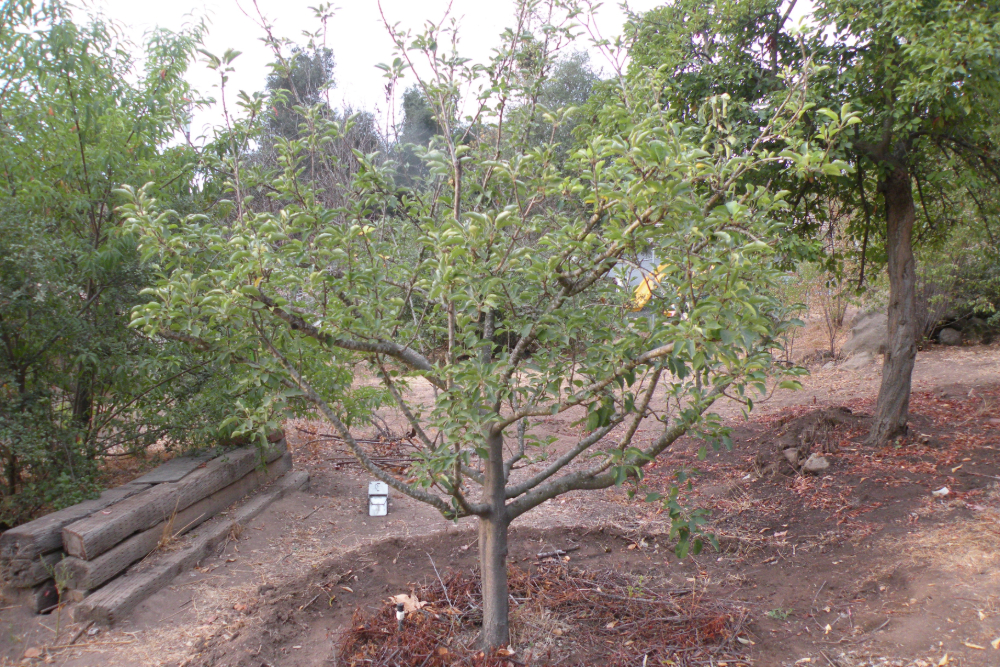
For the new apple trees I have planted, I have usually not cut their leader.
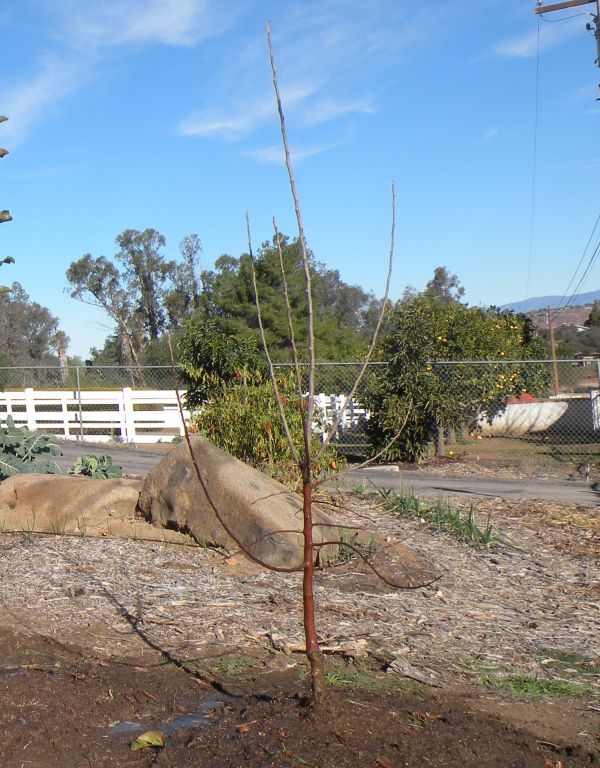
Here is the same Fuji tree today.
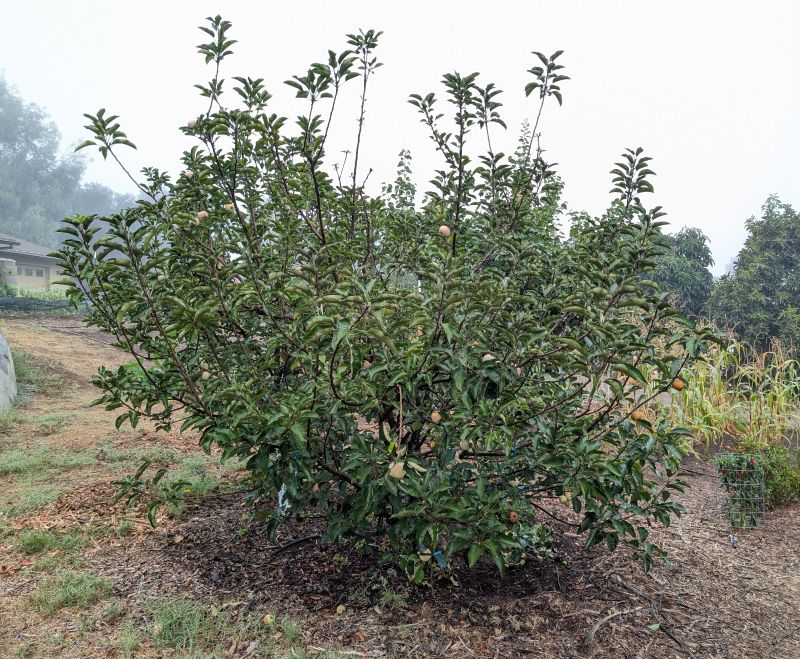
But here is a Pink Lady apple tree that had no side branches (a “whip” they call it). So I cut the leader to get some branching:
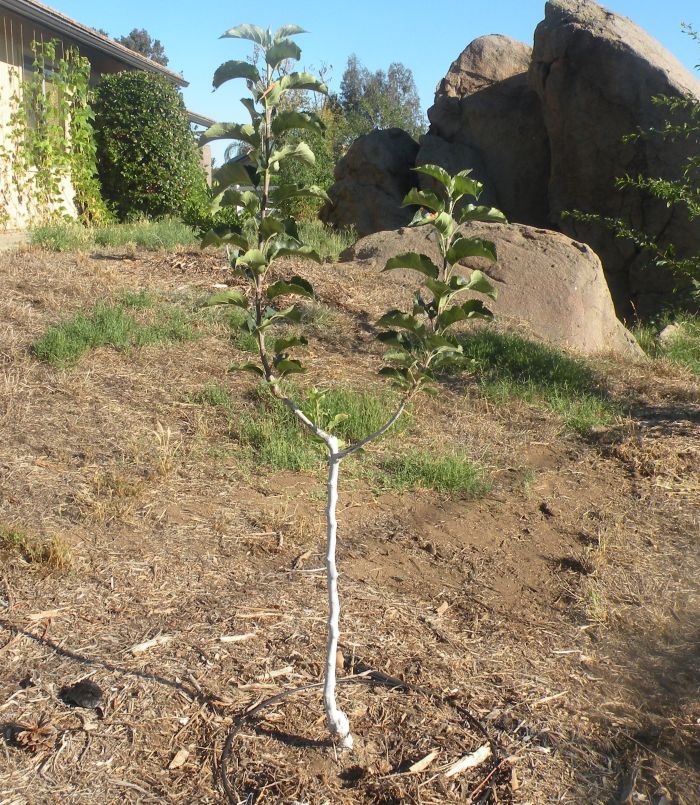
I allowed the center of this Pink Lady to fill with branches, and I did not try to spread the two main branches, and the tree never got sunburned.
If you want to keep an apple tree down to a particular size, then it’s easiest to prune in the winter when you can see the branches without leaves. Do be aware that apples in Southern California lose their leaves late, at the very end of winter, and sometimes they don’t even lose them all.
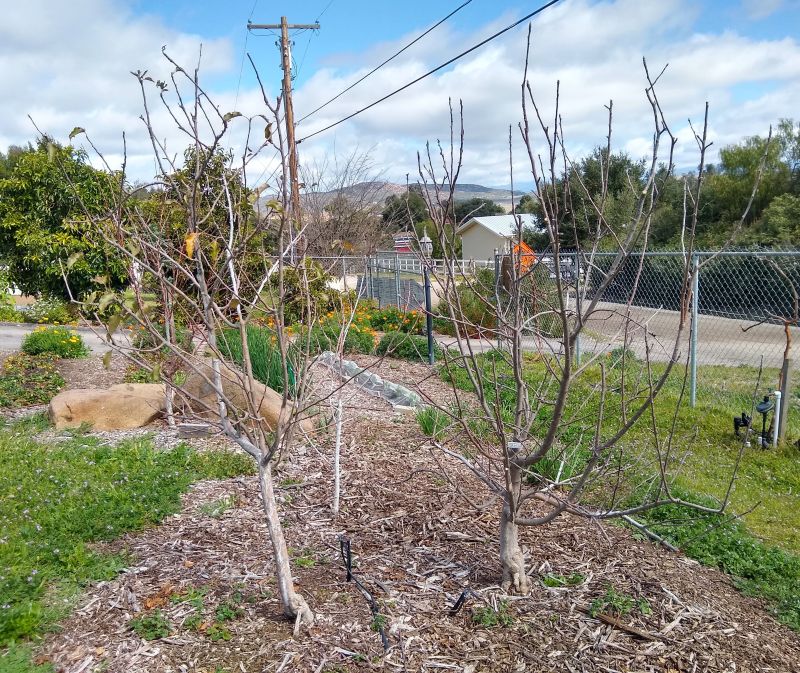
There has been an idea floating around for many years that you should manually strip an apple tree’s leaves at some point in the winter in order to “force dormancy.” I have searched and asked around for evidence that this is beneficial but have never found any. On my trees, I have always allowed them to lose (or not lose) their leaves naturally and they have always bloomed and fruited well.
During winter pruning, keep in mind where apple trees make flowers (and therefore fruit). Apples flower at the tips of branches and on spurs. Spurs are stubby little things that form along the sides of a longer branch.
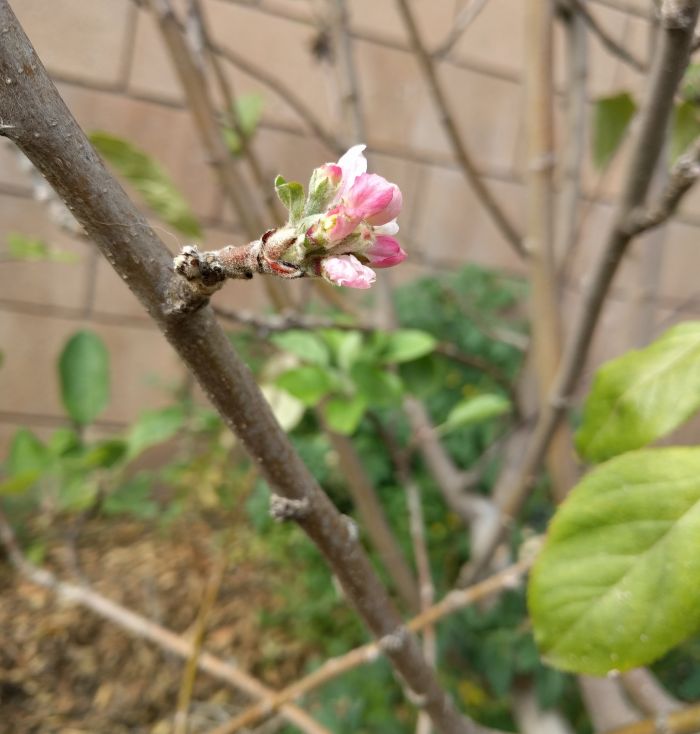
This means: don’t cut the tips of branches or the spurs if you want maximum flowering and fruiting.
But how do you reduce the size of a tree if you don’t cut branch tips? You may have to cut some branch tips, but you can usually accomplish size reduction by entirely removing some of the tallest/longest branches and leaving alone (the tips) of the rest of the branches. (This is called making “thinning” cuts.)
Fruit thinning
Fruit thinning is where you remove some fruit so that the tree’s overall fruit quantity is reduced. Apples make clusters of five flowers (usually five), and all five often become fruit.
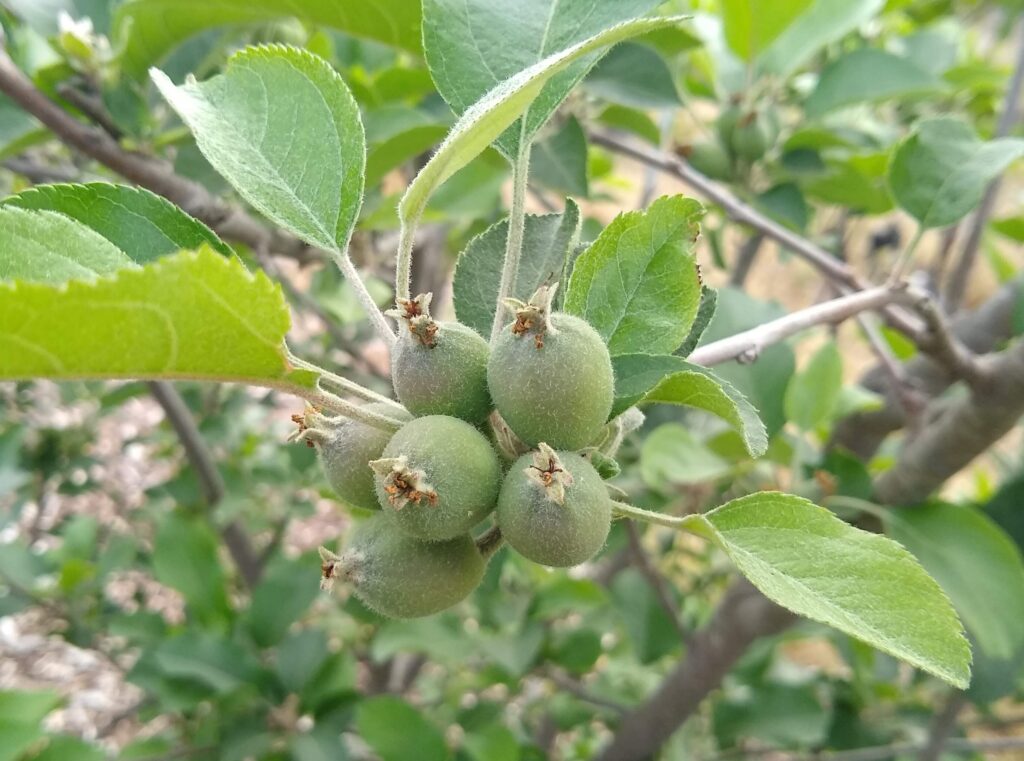
My routine is to reduce each cluster to two. Some apple growers thin to only one.
I also thin to one apple per cluster if there are too many clusters on a single branch, especially a branch that’s thin, and especially near the tip of such a branch.
Why thin apples? A big, old apple tree can handle a heavy crop and not be thinned at all and yet still yield big, quality apples. However, a smaller, younger apple tree will break its branches or be badly sunburned if you do not limit the amount of fruit it holds. I broke a branch on my young Gala tree this summer because I hadn’t removed enough apples.
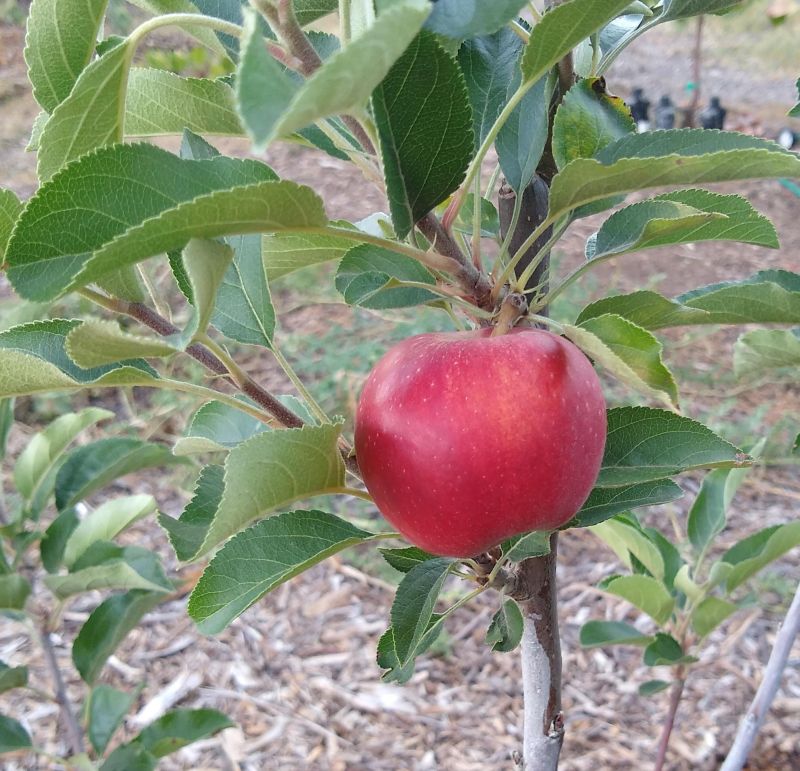
Another reason to thin is to make the remaining apples grow larger. I have read that apples must be thinned within a month of bloom or else the size of the mature apples will not be affected (positively). I don’t know if this is true. I haven’t tried to test it out on my own trees. Regardless, I aim to thin my apples as soon as they reach cherry size.
I find scissors or Felco 320 snips to be the best tools for thinning apples. Apples are hard to thin by hand because the stems are strong (compared to peaches, for example).
Flowering and pollination
Apples flower later than most other deciduous fruit trees (think: apricots, plums, peaches). Also, they sometimes flower again in the summer. This happens with certain varieties (such as Anna) and it can also be instigated by a heat wave.
If you want the most apples from a given tree, it is usually advised to have another variety of apple nearby for cross pollination. But this is certainly not always necessary. I’ve seen many single apple trees in Southern California that produce very well without any other apples nearby. Some such single trees I’ve seen are Fuji, Anna, Dorsett Golden, Pink Lady, Sundowner, Gala, and Granny Smith.
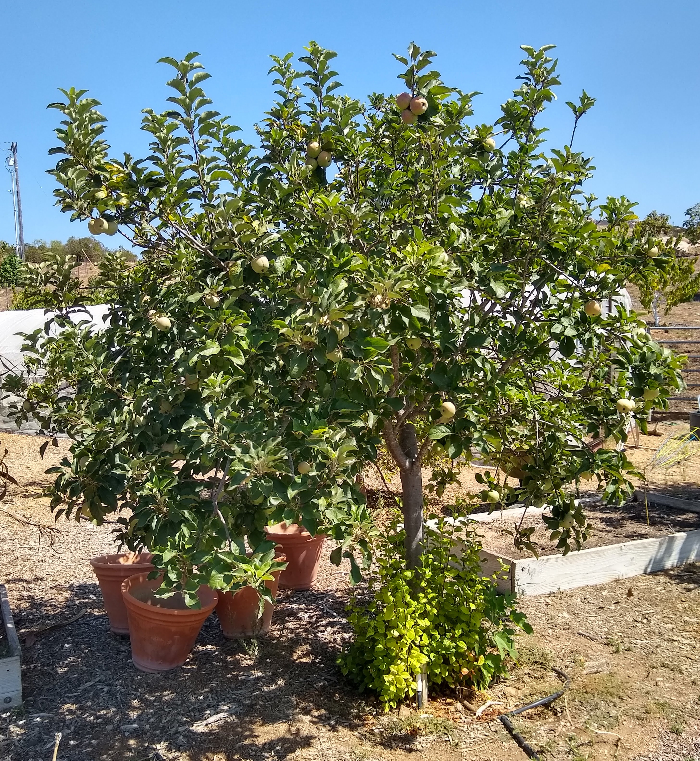
There is a lot of information out there about the needs of different varieties for cross pollination, and the other apple varieties that can be used as pollenizers, but sometimes the information conflicts between sources as well as with my own observations.
For example, Orange Pippin says Fuji is “not self-fertile.” However, I have seen numerous lone Fuji apple trees in Southern California with abundant crops.
Another example: Dave Wilson Nursery says Sundowner is “self-fruitful” on their entry for Home Gardeners. Yet on their entry for Commercial Growers it says for Sundowner that “a pollenizer is recommended for maximum productivity.” Are these both accurate? What should you do? Plant a lone Sundowner tree or also plant a pollenizer variety?
The good news is that apple trees are easy to keep small so you can plant two apple trees very close together and grow them as a single unit. In other words, don’t think that you need the yard space for two full trees in order to grow two varieties. At my previous house in San Diego, I planted Anna and Dorsett Golden trees one foot apart and they grew happily in the space of a single tree. It so happens that a friend did the same in his yard:
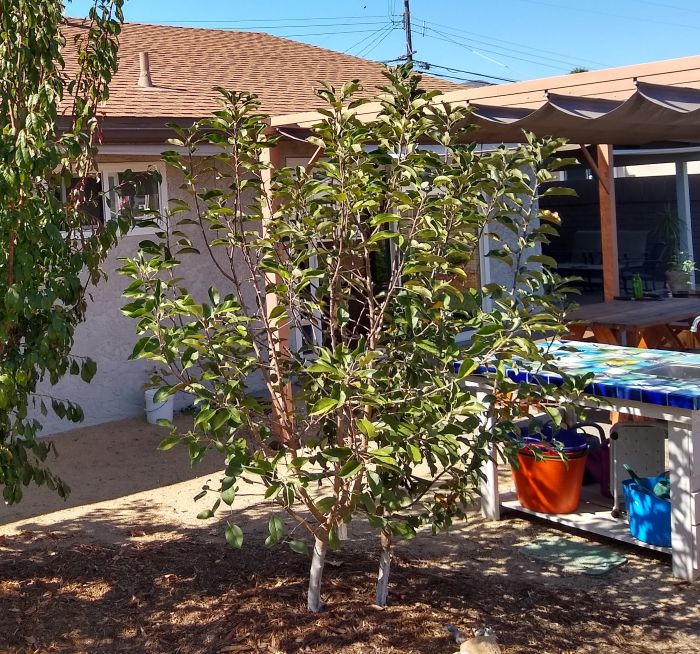
Apples are also easy to graft, easier than many other types of fruit trees. You can graft on a second variety onto a tree in order to ensure maximum pollination and fruit on the main variety. You can also graft on new varieties to a single tree to test how they perform in your yard rather than dedicating entire new trees.
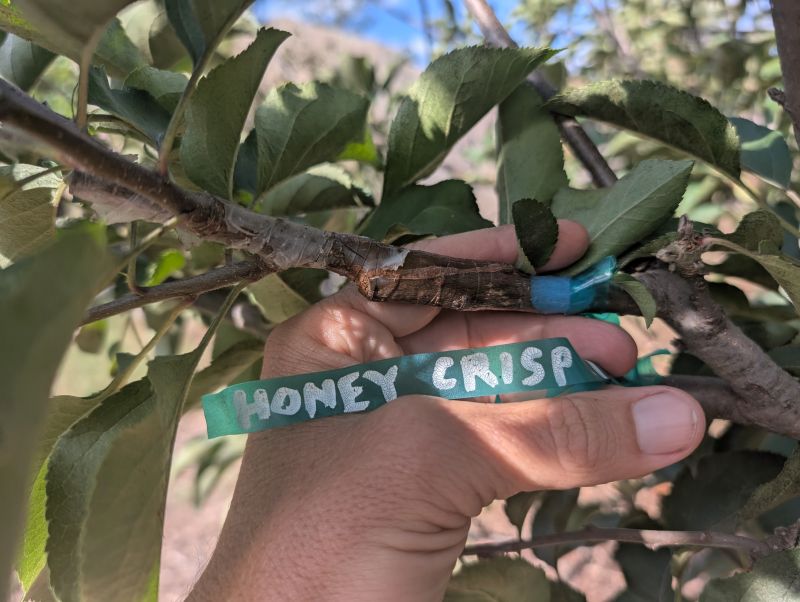
(Here is a post about grafting a branch into an established tree.)
Watering
Apple trees in my yard want about as much water as pears, peaches, and apricots. Here is a post with details: “How much to water a fruit tree in Southern California, roughly.”
But this does depend on the rootstock, among other factors. Some old apples in my yard have been tougher in drought than some old apricot and nectarine trees. And some young apples have been needier than nearby apricots and pluots.
Also, curiously, I have seen apple trees in Southern California doing well with zero irrigation.
Rootstocks
Most of my apple trees are on a rootstock called M-111. It’s the most common rootstock used for most grafted apple trees sold at nurseries in Southern California, and this is because it has a long track record of performing well here.
I have found M-111 satisfactory in my yard, but it does have a couple of quirks. One is that it forms burr knots.
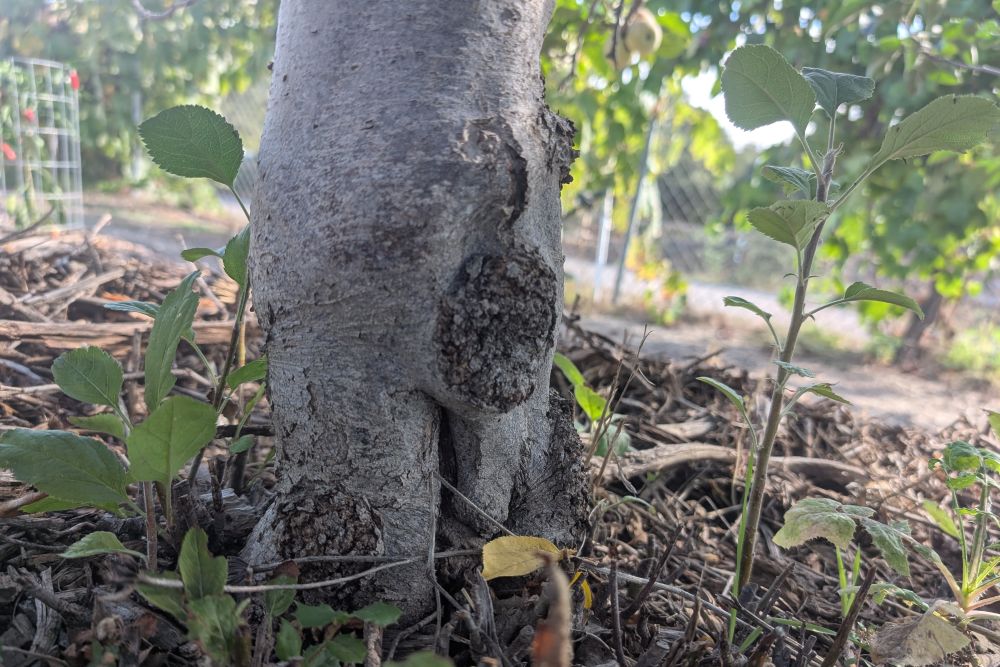
Two is that it sends up rootstock suckers. See above.
Neither of these characteristics is a big problem. Both occur more when the soil or mulch under the tree is eroded. I have trouble keeping the ground under my apples topped up because my chickens love to scratch there. (Maybe this is why I don’t have worms in my apples?)
Fertilizing
I don’t know much about fertilizing apple trees because I’ve never done it. I treat my apples as I treat all of my fruit trees, and that is with some wood-chip mulch underneath. I periodically replenish the mulch as it breaks down.
I’ve also never seen research on apple trees in Southern California comparing fertilizers, composts, or mulches. But I have seen lots of happy apple trees producing well without fertilizers applied so I’m inclined to think they don’t need to be juiced up unless the soil they’re in is particularly, obviously lean.
Protecting fruit
Birds sometimes peck apples. A net can effectively prevent that, as can mesh bags over individual pieces of fruit.
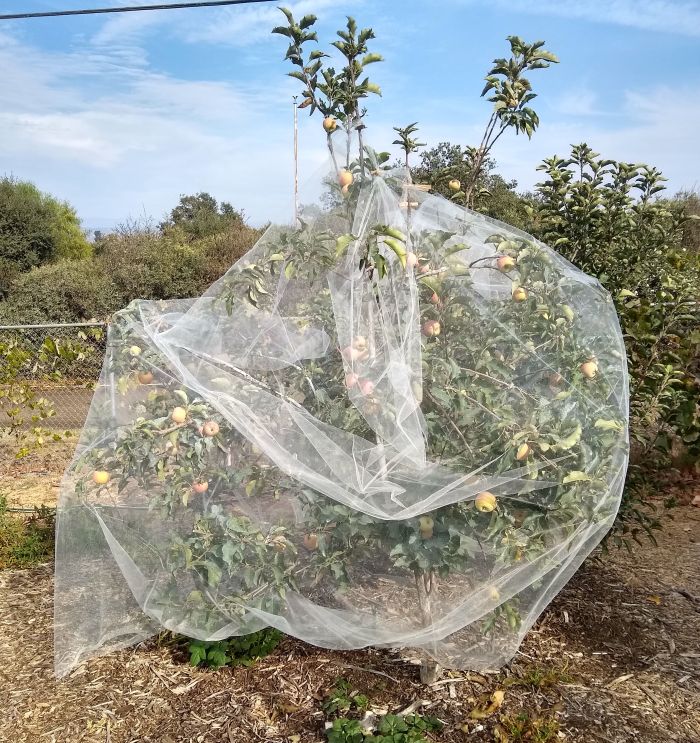
I have tried tying reflective strips in my apple trees, but that didn’t prevent birds from continuing to peck the fruit.
That said, I have not found birds as attracted to apples as much as they’re attracted to peaches, nectarines, cherries, plums, and grapes.
Pests and diseases
I mentioned not having worms in my apples. This is a frequent pest for some. It’s the worm, or caterpillar, of the codling moth that bores into apples. The larvae of this moth are said to mostly develop in cocoons in the dirt and debris below trees, where they pupate and emerge as moths in late winter / early spring. Obviously, down there they would be easy pickings for a scratching chicken.
What to do if you get wormy apples? You might tolerate some damage and eat around the wormy parts; that’s what I always did as a kid with the Granny Smith apples from my grandparents’ tree. Or read here about methods to reduce codling moth damage.
Fireblight occasionally occurs on apple trees in Southern California, but I have seen it only once on one of my trees in the last decade. It doesn’t seem to be an issue worth fretting over.
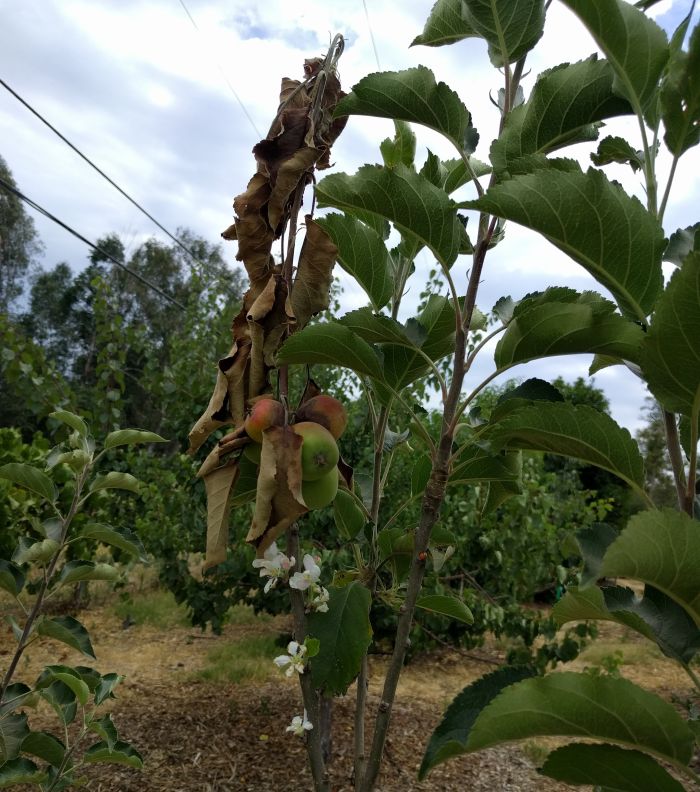
No, apples are not as at home in Southern California as they are in Washington or Oregon.
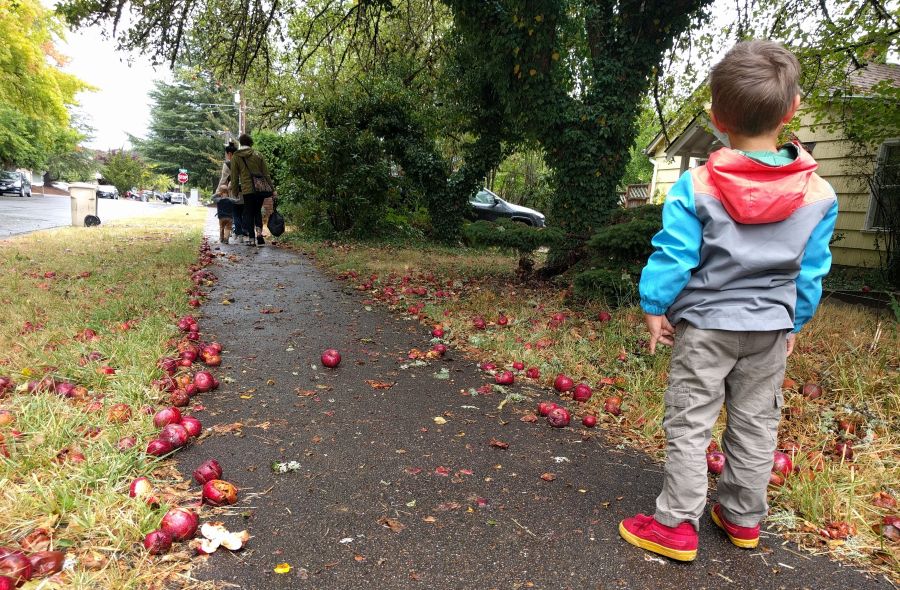
But yes, you should still grow them.
Apples have been grown in Southern California for more than a century. My own great-great grandfather grew apples in the Burbank area. There were apple orchards in Orange County before there were freeways. And of course, there have long been apple orchards up in the San Bernardino Mountains and the Julian area. It’s not a new, experimental crop for this region even though it’s less common in a yard here than a lemon.
So when and where to get started or add more varieties?
When and where to buy apple trees
The best time to buy and plant apple trees is winter, but you should plan in fall.
You can buy from your local nursery when bare-root trees arrive, usually around Christmas. These trees often come from Dave Wilson Nursery, in the Central Valley. Ask your local nursery for the apple varieties they will be getting this winter so you can reserve yours now.
Another good option is to buy from Trees of Antiquity in Paso Robles.
If you’d like to find apple scionwood for grafting, try Fruitwood Nursery up in Humboldt County. Also, keep an eye out for the scionwood exchanges of local chapters of the California Rare Fruit Growers (here is a post about last year’s).

Thank you to all Supporters, who allow me to write these Yard Posts and keep them ad-free. You are generous and I appreciate you.

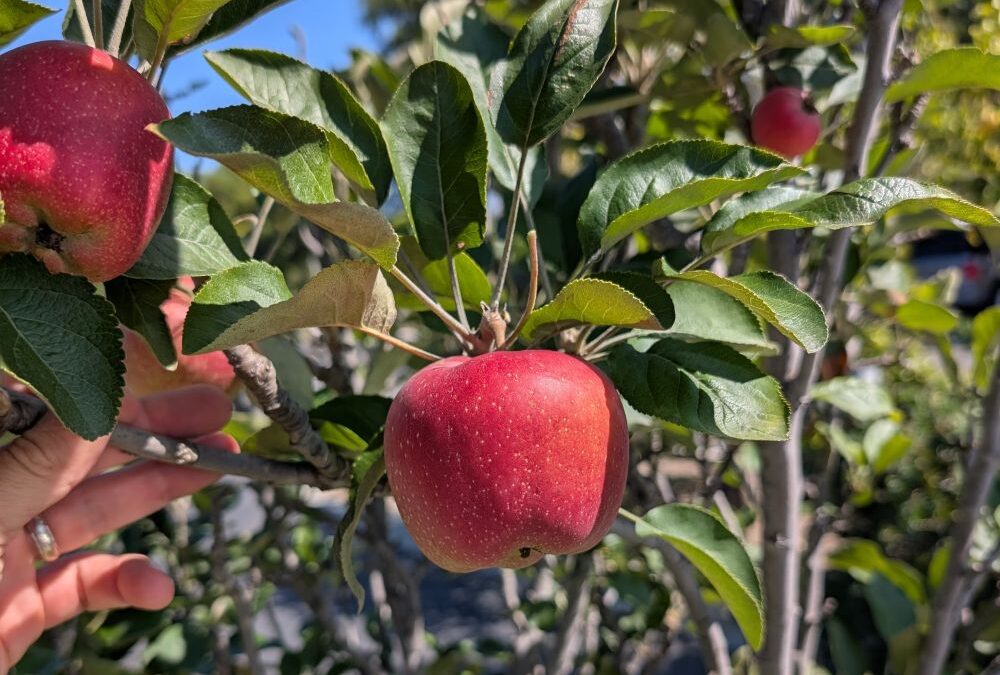


We have 2 Anna apple I keep small-4 feet and they seem happy. Usually get 2 crops every year.
You forgot to tell what kind of apples are in the last picture..
Those look like pluots. Parrots gone feral in Irvine love them and can strip a tree in a day.
My daughter loved apples so I planted a Dorset and the Fuji. The Dorset was to mealy and so I cut it back and grafted the Fuji to it. One day at Costco I saw a variety I never heard of called ambrosia. I decided to try it and found it to be sweet and not tart and a really nice flavor. The following year I looked forward to buying the Ambrosia apples again which I did. And I told a friend if he ever sees an Ambrosia apple tree to purchase let me know. He said I found one and I had him buy it for me and of course reimbursed him. This year it has small apples on it and they taste great just like what I bought in the store. I’m going to graft it to the old Dorset. So if you don’t like tart then you should try the Ambrosia apples and I expect Costco will have them again this year.
To approximate Washington n Oregon apple growing weather a winery in Hot Central Valley occasionally spray trees with water . Wash dust off. Sanitized pruning shears cut off fire Blight at first sight.
Hi Richard, where are you located to plant an Ambrosia apple tree? I also want to plant an Ambrosia apple tree as well in Santa Clara, CA. Do you think Ambrosia which requires many chill hours will thrive in Santa Clara?
I have a golden dorsett (heavy producer) and a pink lady (waiting for first crop). My family’s complaint is the GD is not crisp. Is there a variety i can look for that would be “crisp”? I’m in Corona.
Hi Karen,
I also like my apples crisp. Fuji has a crisp texture to my liking and it will do well in Corona. It’s ripe a bit earlier than Pink Lady so is a nice complement to PL.
Dear Greg Alder,
Thank you for your interest and effort to educate the fruit growers around the world on a regular basis.
Presently I live at Raleigh NC in the USA. I an interested in growing apple like Fuji, Anna, Gala, and Pink Lady, one of each. Can you please suggest where and how do I get them and if I may what may be the cost like.
Thank you.
Dr.Benu Karki
Hello Benu! Great to hear from you, and that you’re in North Carolina now.
I’m sure there are many options closer to you, and that different varieties might be better suited to your location, but Trees of Antiquity will ship to NC.
Hi there! Always appreciate your expertise, so was wondering what you do to prevent loss from squirrels? Our tree has produced 2 beautiful crops and I have yet to taste 1 apple! After losing every single one on our first bumper crop, this year we tried covering each individual apple with a plastic cloche made for this purpose, but no luck! We do get raccoons, possums and skunks as well, but I did catch a squirrel in the act this year- any suggestions about what to try this next year? Sure would love to taste an apple!!
I have the same issue as you, my golden d. apple tree is small, probably planted to close to my large pineapple guava (it won’t get larger than 5 feet tall and about the same diameter, it’s just over 10 years old), but after thinning, I would get 20 apples a little bigger than a golf ball, but once they get about the size of a grape, the squirrels come and steal every last one of them. I’ve netted the tree with bird netting, which only works if it’s a perfect seal. So far, they haven’t been interested enough to chew through the netting for the apples on this tree (they have chewed through the same netting on my plum tree and almond tree). I was considering using (trying) hardware cloth next, but I don’t like that most of them have lead and to build something nearly 8 ft cube is not easy or cheap. One thing that seems to have worked so far is using brown paper bags, was your cover transparent? I think it helps if they cannot see what is there, but I’ve only done it on a few of them. I also have possoums, rats, and some times raccoons, but I saw 2 squirrels come every day and take 4 or 5 apples until they were all gone…
Hi Jeff figured I wasn’t the only one! I was going to try a net this coming season, but unfortunately don’t have much faith. Might try it in combination with cloche. The cloche’s we used this year were a translucent green, I like your idea of using lunch bags
I’ve been using “fruit protection wire mesh bags” from Amazon on my mangos, and I’m sure they’d work for apples too. They’re kind of like chain mail for your fruit (but much lighter so they don’t weigh the branches down). The squirrels haven’t been able to chew through them so far.
I espaliered an Anna apple tree at my front walkway. It’s really an experiment in how to do things wrong (pruning, irrigation, sunlight, etc), but I still get a decent harvest! It’s the best conversation piece in the spring when it has fruit. I’m so glad I went for it and tried a new fruit and pruning method. It only receives a 1/2 day of sun and fruits regardless, which is shocking. I’m inland (Temecula) so maybe that’s enough of our intense sun.
Thanks Greg for this post! I’m going to try Pink Lady thanks to your suggestion.
Always love your new content!! We had a very prolific Gravenstein this year and it takes time to process it all to maximize use! Love it in pie though harvested in August I prep and freeze until Thanksgiving. I really love Pink Parfait and some of the red fleshed apples but their season is fleeting.
Microclimates might make a difference in which varieties do well at a particular location. Near the coast, I’ve found that Granny Smith, Lady Williams, Williams Pride, Cinnamon Spice grow and produce well. Arkansas Black, King David, Akane grow more slowly but still produce well. Honeycrisp, Wealthy, Liberty, Wynoochee Early grow poorly, struggle to come out of dormancy in the spring/summer, and make few apples.
Thanks for the report, Abe. I’m twenty miles inland and at 1,500 feet elevation in San Diego County, and I’ve got test grafts of a few of those varieties (Lady Williams, Arkansas Black, Honeycrisp) so it will be interesting to see if they act any differently here.
Thinking about microclimates, I’ve got a section of my yard that is relatively low and cold, and I’ve had damage on avocados planted there almost every winter. My plan is to replace a couple of those avocados with apples this winter.
May gray / June gloom seems to be a major climate influence near the coast. It can send them back into dormancy just as they’re starting to wake up. Then they don’t wake back up until Aug or Sept. Some of the varieties that apparently grew well for Kuffel Creek or Tom Spellman’s test orchard were not successful in my yard. I think they need some heat and sun in the spring.
Almost 2 years ago, I planted a Dorset Golden and an Anna apple. The Anna, surprisingly, produced the first and second summer, thought something stole the small fruits before ripening. Just in the last few months, the Anna suddenly succumbed to something (fireblight?) where everything above a certain point withered instantly. Then the rest died about six weeks later. I want to replace it with another tree, but don’t want to make the same mistake. Any advice?
I get rampant fireblight where I live in the Inland Empire. It decimates any tree that’s susceptible, so I’ve ended up removing my loquats, quince, apples, etc.. I have yet to find a low-chill apple variety that has decent fireblight resistance. I would love to know if anyone has any suggestions!
Hi Holly,
Bummer about the fireblight. That condition is a mystery to me. I wonder why you would get it so much whereas I’ve seen some apple trees in the same Inland Empire region that don’t.
I find the typical advice about preventing and managing fireblight, as well as the categorizations of varieties’ susceptibilities, to be unconvincing.
For example, you find a University of California article listing Gala as one of the “more susceptible” varieties, but a Washington State article lists Gala as “moderately to highly resistant.”
https://ipm.ucanr.edu/home-and-landscape/fire-blight/pest-notes/#gsc.tab=0
https://treefruit.wsu.edu/article/fire-blight-susceptibility-of-apple-cultivars/
All I know is that I’ve got a Gala that has never had fireblight, and I know a couple friends in Southern California with Gala trees and no fireblight problems. But maybe there are others that get it?
I don’t know what to do except to look around your neighborhood for apples that are doing well. Try to learn the variety and rootstock, and then the style of care, and then copy.
Thanks so much for your response, Greg, and for your advice! Yes, I noticed the same contradictions when I was looking up fireblight resistance in low chill apples, and it was really frustrating. I’ll look more closely for apple trees in my area and maybe experiment with Gala. The worst that can happen is that I’d have to take it out.
Hi Greg. You may not know since you already had several apples on the property when you moved in, but do you think the typical advice that apple trees are not self fertile and you must have at least two is true? I really want an apple tree but don’t have room for two. A neighbor does have one (and I produces apples with just the one which is why I’m questioning this, plus your article didn’t mention it) but mine wouldn’t be right near hers. Thanks!
Hi Mackenzie,
I know for sure that you do not need two apple trees in order to get fruit. I can think of so many single apple trees around Southern California that fruit well.
You may get more fruit with multiple trees, but I can say that for sure you will get at least a moderate crop from many varieties as lone trees.
Plant that apple you have been wanting!
Hooray! Thank you!
Hi Greg,
Thank you for apples growing post.
I’m in Fullerton, and we planted a few heirloom apple trees purchased from Trees of Antiquity and planted in January 2024. We now have an Ashmead Kernel, Hauer Pippin, Pettingill, Gilbert Gold, Snow Fameous–along with existing trees Fuji, Braeburn and Pink Lady. We harvested fruits already off those trees this year. All the apple trees grew really well with last years rain, fruits were very crunchy and sweet.
I had a chance to taste a Golden Russet while in New York last year. So this year, plans for 3 more apple trees: Golden Russet, Mutsu and Caville de Blanc.
When we moved in, the property already had an Anna that must be over 25 years old, with termited trunks and neglected. My husband revived the tree and we harvested over 50lbs of fruits in June/July.
There are hundreds/thousands of apples varieties–with new ones being bred every year, it’s like being in a candy store!
Thank you!
This is great news, Bick. Thanks for sharing. Please continue to update as those trees go along.